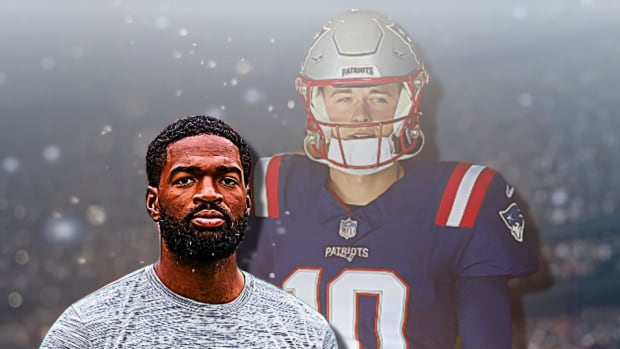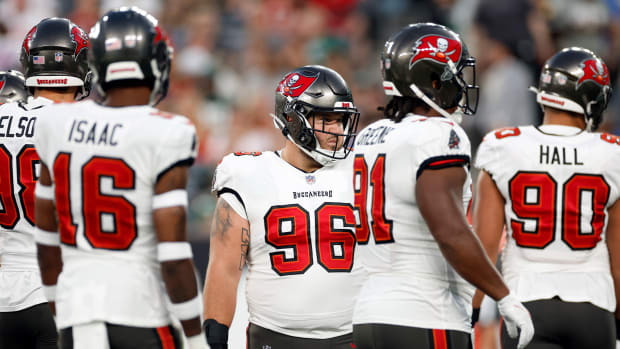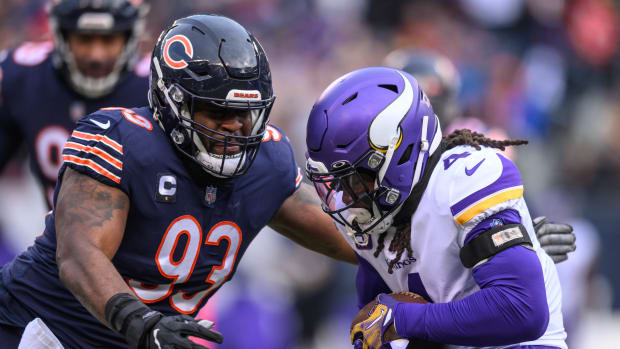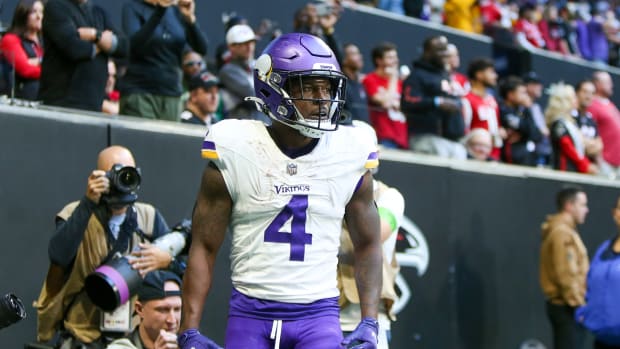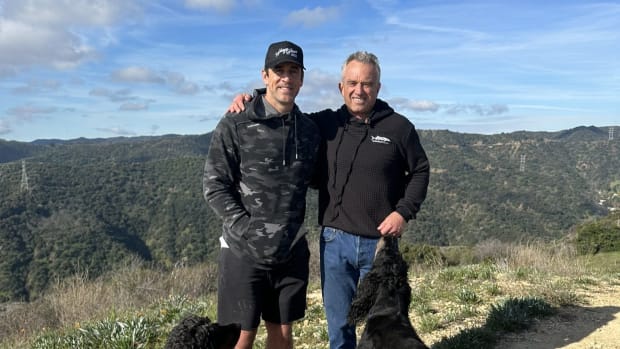How NFL teams split their spending between offense and defense
With the vast majority of contracts for the upcoming NFL season settled, the time to address roster weaknesses through the draft and free agency has just about come and gone.
Plenty of money changed hands earlier this off-season as front offices hope to find the right balance of offense, defense and special teams. In their quest to do that, some general managers shelled out substantial cash to try and correct their thinnest position groups and units, while others chose the cheaper routes of drafting for need and grooming young players for larger roles. How each team allocates its money offers a window into the urgency behind the off-season's efforts to retool for another run at contention, as well as the adversity facing the teams rebuilding some of the league's worst units.
• Audibles Podcast: NFL's best players by number | The list: 00–49 | 50–99
The Colts are the only team projected to fork out virtually the same amount of cash ($68.8 million) to offensive and defensive players, but elsewhere around the league there are some telling allocation splits on both sides of the ball. With the help of PointAfter visualizations, I’ll break down the teams who are dedicating the highest proportion of their payrolls to offense and defense.
Note: All salary figures are courtesy of Spotrac.
Offense
Three teams spend a league-high 57% of their payroll on offense: the Falcons, Redskins and Vikings. Minnesota has set aside the most raw cash on that side of the ball ($83.2 million) in an effort to surround Teddy Bridgewater with a capable supporting cast after the team finished 27th in total offense last season.
Note: You can hover over each dot to see the team and data points it corresponds to.
2014 Total Offense vs. 2015 Offense Salary | PointAfter
Several factors have left the Vikings out on the extreme of the graph above (and far below the league trend line). The most obvious one is Adrian Peterson’s $15.4 million cap hit, which sticks out more and more around the league as teams move away from lengthy guaranteed deals for running backs. Including the $6 million of dead money that Greg Jennings will count against Minnesota’s cap, seven of the Vikings’ eight highest-paid players are on offense.
Overrated to underrated: NFL stars who have experienced the career shift
The most noteworthy acquisition among that group this off-season was wide receiver Mike Wallace. The Vikings must have faith in both Wallace’s abilities and coach Mike Zimmer's defensive acumen, because they were left with just about $55 million to pay their defense, which ranks in the bottom 10 for defensive units.
As for the team with the lowest proportion of its payroll earmarked for offense? That’d be Wallace’s former team, the Dolphins (38%). With Ryan Tannehill's recent four-year extension yet to kick in, the only two offensive players set to count more than $5 million against Miami’s salary cap this season are left tackle Branden Albert and center Mike Pouncey.
Miami Dolphins - 2015 Team Payroll | PointAfter
One more team to highlight here: Jacksonville. The Jaguars front office is finally addressing its offensive woes with the checkbook, rationing 56 percent of its 2015 payroll to offense, the fourth-highest proportion in the league.
• SI.com's off-season report cards: Grading every team's moves
A lot of that comes from the contract of tight end Julius Thomas, who became the team’s second-highest-paid player after signing a five-year, $56 million deal in March. But the team also signed former Cowboys tackle Jermey Parnell (five years, $32 million), who showed immense promise in part-time duty on the league’s best offensive lines last season.
Julius Thomas - Contract Details | PointAfter
Defense
The Browns have allocated a league-high $82.1 million this season to their defense, which is projected to take up 54 percent of Cleveland's 2015 payroll. The Browns are the only team spending over half of its cap space on that side of the ball.
That philosophy may stem from Browns owner Jimmy Haslam’s desire to build a hard-nosed team similar to the Steelers franchise he once owned a minority stake in. A big reason why Haslam has the freedom to lavishly spend on defense is his team’s enviable situation regarding dead money.
Cleveland Browns - 2015 Team Payroll | PointAfter
[daily_cut.nfl]Cleveland currently has just $1.9 million of dead money on its 2015 payroll due to former players who were cut or traded. The Browns have largely avoided being hamstrung by unwieldy long-term contracts. Even Ben Tate, who was cut after a massively disappointing first year, is only taking up $750,000 in 2015.
All that’s left for the Browns’ defense to do is actually earn its extravagant collective salary. Cleveland finished 23rd in total defense in 2014 and gave up a league-worst 141.6 rushing yards per game. General manager Ray Farmer has rewarded marquee secondary members such as Joe Haden and Donte Whitner, and the selection of hulking defensive tackle Danny Shelton in the first round of this year's draft suggests the team is taking the cheaper route in building up the trenches with young talent.
Worst Rushing Defenses in 2014 | PointAfter
The Falcons have the league's widest gap between their projected costs on defense ($40.8 million) and offense ($77.2 million), and they got what they paid for in fielding the league’s worst defense in 2014. Even for a team spending so little on that unit, it’s shocking to see how far away they are from the trend line in the interactive graph below.
2014 Total Defense vs. 2015 Defense Salary | PointAfter
The Falcons didn’t make a splash in free agency to address those concerns, with the addition of defensive end Adrian Clayborn on a one-year deal their most significant move. Instead, they elected to build through the draft with No. 8 pick Vic Beasley and second-round cornerback Jalen Collins. Even if Beasley exceeds expectations in his rookie year, it’s hard to envision Atlanta’s defense making big strides in 2015 given how many holes they still have.
Off-season report card: Atlanta Falcons
The NFC South as a whole has a tendency to underspend on defense, a trend that cost the division dearly in 2014. The franchises haven’t learned their lesson, apparently.
Despite New Orleans’s much ballyhooed commitment to defense following a complete breakdown there in 2014, the Saints are still projected to allot 48% of their cap on offense, compared to 35% on defense. One roadblock to their plan? Dead money is consuming 14% of their payroll, thanks largely to the combined $20 million that departed contributors Jimmy Graham, Ben Grubbs and Curtis Lofton will keep occupy on the cap this season.
That’s not as bleak as Tampa Bay’s situation, however. The Buccaneers have to commit a league-high 18% of their salary cap to dead money, leaving them projected to distribute a league-low 29% of the payroll to defense.
Even the relatively solid Panthers have $52 million allocated for defense, the seventh-lowest projected total in the league.
Will the NFC South be as bad as it was in 2014? That’s unlikely, if only because it might have been the worst division in NFL history last year. But if team finances are any indication, we almost certainly won’t be seeing a marquee defense lift any of those four teams back to respectability.
More from Will Laws:
The Most Overpaid NFL Players at Each Position
Which NCAA conference is the best at producing Pro Bowlers?
PointAfteris part of theFindTheBestnetwork, a research website that’s collected all the information about Mike Wallace and the Minnesota Vikingsand put it all in one place so you don’t have to go searching for it.
Join FindTheBest to get all the information about NFL players, NFL teams and thousands of other topics.
































